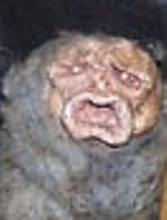In the first chapter of the book there is a brief reference to the Leopard Men of the Congo, known as the Anioto. Quammen is discussing the different manifestations of predators in religious symbolism and in the eastern Congo there was a belief in shape-shifting between leopards and humans. The Anioto were not shapeshifters - they were just human beings who, according to the stories, would dress in leopard skins (even with an attached tail), walk on all fours and roar like the beasts. But the really interesting thing about the Anioto is that they made claw-like weapons to imitate the teeth and claws of the leopard. This they used to kill and subsequently blame their murders on real leopards.
This short description of the Anioto stuck with me, because it precisely mirrors part of my MA-project on animal imagery in horror films, where the desired weapons of choice are usually reminiscent of teeth and claws. More modern weapons, such as guns or flame-throwers, are not common in the typical horror film, and neither are far-ranging weapons such as a bow or arrow. Most of the weaponry aim at close-range kills, with knives, machetes, axes, saws and the like being the paradigm examples. Indeed, when Wes Craven was trying to decide on a weapon for his invention of Freddy Krueger for the first A Nightmare on Elm Street film, he thought about the collective human sub-conscious and went back to our most primal fear - that of man-eating predators - and ultimately created the infamous dagger-hands, as a direct reference to our old animal enemies.
I did a quick search for more information about the Anioto Leopard Men, but didn't come up with much, apart from this article by David Arthur Adams. It discusses the "Real" Leopard Men, taking one of Edgar Rice Burroughs' Tarzan stories as a starting point. Indeed, Tarzan not only fought the Anioto in the original book (which you can read here), but also in an Italian 1964 film, as well as the better known 1946 Weissmuller film Tarzan and the Leopard Woman.

No comments:
Post a Comment